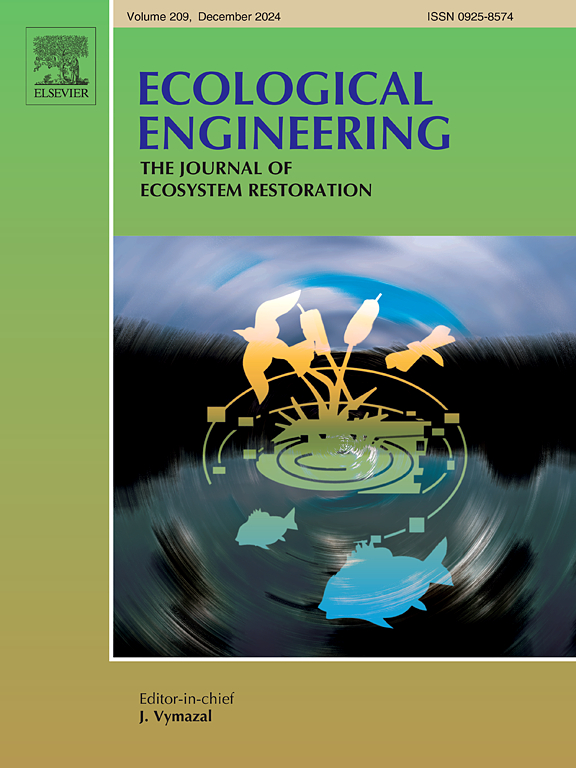基于生态系统的海洋综合区划实践与评价——以南通市为例
IF 4.1
2区 环境科学与生态学
Q1 ECOLOGY
引用次数: 0
摘要
基于生态系统的海洋空间规划是缓解海洋生态保护与资源开发冲突的有效途径。本文应用马克思模型对南通海域多重保护标准的海洋生态区进行了划分。通过整合资源利用区划,制定了两个生态保护程度不同的综合区划方案。这一过程是在马克思模式下,通过考虑资源利用区划对生态保护的影响,调整生态保护成本。目标是对生态分区和综合分区进行优化,同时对综合分区优化方案的空间结构和整体效益进行评价。建议的综合分区优化方案将34.19%的面积分配给生态保护区,2.95%的面积分配给生态控制区。海洋开发区和保护区分别占总面积的27.22%和35.64%。生态保护区有效地实现了保护目标,而控制区和保护区则起到了保护区与开发区之间的缓冲作用,为未来海洋开发保障了充足的空间资源。在优化方案评价中,生态保护区和保护区各占面积的35%左右,海岸线开发面积不超过30%。超过35%的典型断面处于生态保护状态,40%的典型断面处于保护状态。此外,推荐方案优化了保护成本、保护区紧凑性和经济效益。本研究以南通海域为例,概述了海洋从单一区划到综合区划、从综合区划到优化综合区划和方案评价的技术过程。为评价微型微型电网方案提供了科学的方法,为中小型微型微型微型微型电网项目提供了详细的参考。本文章由计算机程序翻译,如有差异,请以英文原文为准。

The ecosystem-based marine comprehensive zoning practice and evaluation: A case study of Nantong, China
The ecosystem-based Marine spatial planning (MSP) is an effective approach to mitigate conflicts between marine ecological conservation and resource exploitation. This study applies the Marxan model to delineate marine ecological zones with multiple protection standards in the Nantong Sea, China. By integrating resource-use zoning, two comprehensive zoning schemes with varying degrees of ecological protection are developed. The process involves adjusting the ecological protection costs within the Marxan model by accounting for impacts of resource-use zoning on ecological conservation. The goal is to optimize both ecological and comprehensive zoning, while evaluating the spatial structure and overall benefits of comprehensive zoning optimized schemes. The recommended comprehensive zoning optimized scheme allocates 34.19 % and 2.95 % of the area to ecological preservation zones and ecological control zones, respectively. Marine development zones and reserve zones account for 27.22 % and 35.64 % of the area. Ecological preservation zones effectively fulfill protection objectives, while control zones and reserve zones serve to buffer preservation areas from development zones, safeguarding sufficient spatial resources for future marine development. During the evaluation of the optimized scheme, ecological preservation zones and reserve zones each account for approximately 35 % of the area, with the developed coastline comprising no more than 30 %. More than 35 % of typical cross-sections are in an ecological preservation state, while 40 % are in a reserved state. Additionally, the recommended scheme optimizes protection costs, the compactness of preservation zones, and economic benefits. This study, using the Nantong Sea as a case study, outlines the technical process from marine single zoning to comprehensive zoning, and from comprehensive zoning to optimized comprehensive zoning and scheme evaluation. It provides a scientific approach for assessing MSP schemes and offering detailed references for mid- to small-scale MSP projects.
求助全文
通过发布文献求助,成功后即可免费获取论文全文。
去求助
来源期刊

Ecological Engineering
环境科学-工程:环境
CiteScore
8.00
自引率
5.30%
发文量
293
审稿时长
57 days
期刊介绍:
Ecological engineering has been defined as the design of ecosystems for the mutual benefit of humans and nature. The journal is meant for ecologists who, because of their research interests or occupation, are involved in designing, monitoring, or restoring ecosystems, and can serve as a bridge between ecologists and engineers.
Specific topics covered in the journal include: habitat reconstruction; ecotechnology; synthetic ecology; bioengineering; restoration ecology; ecology conservation; ecosystem rehabilitation; stream and river restoration; reclamation ecology; non-renewable resource conservation. Descriptions of specific applications of ecological engineering are acceptable only when situated within context of adding novelty to current research and emphasizing ecosystem restoration. We do not accept purely descriptive reports on ecosystem structures (such as vegetation surveys), purely physical assessment of materials that can be used for ecological restoration, small-model studies carried out in the laboratory or greenhouse with artificial (waste)water or crop studies, or case studies on conventional wastewater treatment and eutrophication that do not offer an ecosystem restoration approach within the paper.
 求助内容:
求助内容: 应助结果提醒方式:
应助结果提醒方式:


